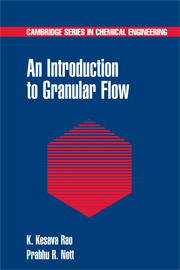Book contents
- Frontmatter
- Contents
- Preface
- Notation
- 1 Introduction
- 2 Theory for Slow Plane Flow
- 3 Flow through Hoppers
- 4 Flow through Wedge-Shaped Bunkers
- 5 Theory for Slow Three-Dimensional Flow
- 6 Flow through Axisymmetric Hoppers and Bunkers
- 7 Theory for Rapid Flow of Smooth, Inelastic Particles
- 8 Analysis of Rapid Flow in Simple Geometries
- 9 Theory for Rapid Flow of Rough, Inelastic Particles
- 10 Hybrid Theories
- Appendix A Operations with Vectors and Tensors
- Appendix B The Stress Tensor
- Appendix C Hyperbolic Partial Differential Equations of First Order
- Appendix D Jump Balances
- Appendix E Discontinuous Solutions of Hyperbolic Equations
- Appendix F Proof of the Coaxiality Condition
- Appendix G Material Frame Indifference
- Appendix H The Evaluation of Some Integrals
- Appendix I A Brief Introduction to Linear Stability Theory
- Appendix J Pseudo Scalars, Vectors, and Tensors
- Appendix K Answers to Selected Problems
- References
- Index
Appendix G - Material Frame Indifference
Published online by Cambridge University Press: 19 November 2009
- Frontmatter
- Contents
- Preface
- Notation
- 1 Introduction
- 2 Theory for Slow Plane Flow
- 3 Flow through Hoppers
- 4 Flow through Wedge-Shaped Bunkers
- 5 Theory for Slow Three-Dimensional Flow
- 6 Flow through Axisymmetric Hoppers and Bunkers
- 7 Theory for Rapid Flow of Smooth, Inelastic Particles
- 8 Analysis of Rapid Flow in Simple Geometries
- 9 Theory for Rapid Flow of Rough, Inelastic Particles
- 10 Hybrid Theories
- Appendix A Operations with Vectors and Tensors
- Appendix B The Stress Tensor
- Appendix C Hyperbolic Partial Differential Equations of First Order
- Appendix D Jump Balances
- Appendix E Discontinuous Solutions of Hyperbolic Equations
- Appendix F Proof of the Coaxiality Condition
- Appendix G Material Frame Indifference
- Appendix H The Evaluation of Some Integrals
- Appendix I A Brief Introduction to Linear Stability Theory
- Appendix J Pseudo Scalars, Vectors, and Tensors
- Appendix K Answers to Selected Problems
- References
- Index
Summary
As noted in §1.5.1, a reference frame consists of a spatial coordinate system and clock. The principle of material frame indifference requires constitutive equations to be invariant or unaffected by an arbitrary time-dependent translation, rotation, and reflection of the coordinate axes and by an arbitrary translation of the time axis. In contrast, constitutive equations expressed in tensor form are invariant under time-independent transformations of the coordinate axes, but they are not necessarily invariant under time-dependent transformations.
The basis for frame indifference is the intuitive idea that the response of a material should be independent of the motion of the observer (Oldroyd, 1950; Noll, 1955, p. 45; Noll, 1959). The principle cannot be proved, but simple examples have been given (Truesdell and Noll, 1965; Hunter, 1983, p. 123) where its validity appears plausible. An example taken from Hunter (1983, p. 123) is discussed below.
A pilot bails out of an aircraft and opens his parachute. Suppose that the force P exerted by the parachute on the pilot is measured by the extension of a spring attached to the harness of the parachute. Consider two reference frames, one fixed to the pilot and the other to an observer standing on the ground. Suppose that the spring is visible in both the frames. When relativistic effects are ignored, it is usually implicitly assumed that at any time t, the distance between two points in space has the same value regardless of the motion of the reference frame (see, e.g., Resnick, 1968, p. 5). This assumption implies that the pilot and the observer on the ground will record the same extension for the spring.
- Type
- Chapter
- Information
- An Introduction to Granular Flow , pp. 439 - 448Publisher: Cambridge University PressPrint publication year: 2008



